Ask yourself this question. Do your team members lose entire Fridays piecing together client reports? Many agencies share this struggle. Skilled SEO experts waste hours wrestling with spreadsheets when they could devise powerful strategies.
Crunch the numbers. Dedicate 5 hours per client to monthly reports, handle 10 clients, and lose 50 hours each month. Channel that time into sharper client plans, new business pitches, or a stress-free weekend before Monday deadlines loom.
I’ve watched agency leaders grapple with reporting as a necessary chore for years. Many hesitate to adopt tools, viewing them as added costs.
Choose the right SEO reporting software to protect profits. Strengthen client trust and free your team to focus on tasks that deliver real impact.
Why SEO Reports Strengthen Client Relationships
When you create SEO reports for your clients, it serve as the backbone of client relationships, far more than just deliverables. Answer clients’ questions about their investment with clear, compelling data.
Clients today demand insights beyond rankings or traffic stats. Craft reports that tell a story, detailing what changed, why it occurred, and what actions follow.
Demonstrate how your work boosts their revenue. Observe how top agencies keep clients for years while others face constant turnover?
Quality reporting makes the difference. Deliver clear, actionable reports to build trust and justify fees. Confuse clients with vague data, and they’ll question your worth.
Why Excel Fails for Scaling Agencies
Spreadsheets seem cost-effective at first. Manage one or two clients, and Excel might work. Scale to more, and chaos takes over.
Handle 15 clients, each needing monthly reports. Assign someone to log into multiple platforms, export data, format charts, and write explanations.
Errors creep in. Formatting falters. Reports lose polish. Month-end tasks turn into a nightmare your team dreads. Cut reporting time by 80% to unlock growth.
I’ve seen this shift transform agencies. Excel falls short for these reasons:
- Hours drag on. Finish in 20 minutes what takes 4 hours in Excel with a dedicated tool.
- Mistakes multiply. Mistype a formula, and the entire report falters. Trust your data’s accuracy?
- Scaling breaks it. A process for 3 clients collapses with 10 or more.
- Charts look dated. Clients judge your expertise by your reports’ professionalism.
What Are Essential Features of an SEO Reporting Tool
Some tools produce flashy charts; others revolutionize your operations. Seek these must-have features to maximize value.
Comprehensive Data for Clear Insights
Collect every critical SEO metrics: rankings across search engines and regions, organic traffic with user behavior, technical issues, backlink growth, and competitor benchmarks.
Turn raw numbers into actionable insights. Identify why traffic dipped. Spot untapped opportunities. Prioritize high-impact strategies.
Visuals That Engage Clients
Lose clients’ focus with dense data tables? SEO specialists love spreadsheets, but clients need visuals that clarify.
Select tools with interactive dashboards, tailored charts, and highlighted insights. Create moments when clients grasp your work’s impact.
Branding That Reflects Your Agency
Showcase your agency’s identity in every report, not a software logo. White-labeling builds a professional image.
Customize logos, colors, and dashboard domains to create a seamless client experience.
Workflow That Simplifies Operations
Streamline behind-the-scenes tasks. Create one report template and apply it to all clients. Schedule automatic delivery.
Enable smooth team collaboration. These features save hours and reduce frustration.
Six Critical SEO Report Types for Clients
Tailor reports to diverse client needs. Equip your tool to produce these six essential report types:
Executive Dashboard for Decision Makers
This high-level overview is designed for decision-makers who don’t need to dive into technical details. It should show overall organic traffic trends, conversion and revenue metrics, year-over-year comparisons, and goal achievement at a glance. Think simple visualizations that tell the story in seconds.
Technical SEO Report for Site Health
This more detailed report documents site health and technical optimization progress. It should include crawl errors, page speed metrics, mobile usability issues, indexation trends, and Core Web Vitals performance. It’s typically more technical but still needs to connect issues to business impact.
Keyword Performance Report for Search Visibility
This report tracks visibility in search, showing ranking distribution (positions 1-3, 4-10, 11-20), featured snippet presence, keyword movement over time, and competitive rank comparison. For local businesses, local rank tracking is essential to show geographic performance.
Content Performance Report for Business Results
This analysis shows how SEO content drives business results, highlighting top-performing pages by traffic, engagement metrics by content, conversion attribution to content, and content-driven backlink acquisition. It helps justify content investments by connecting them to outcomes.
Link Building Report for Backlink Growth
This documents backlink profile improvements, showing new links acquired, link quality metrics, referring domain growth, and competitor backlink comparison. It demonstrates the often-invisible work of link building in a tangible way.
Local SEO Report for Geographic Performance
For businesses serving specific geographic areas, this tracks local search visibility, including local pack rankings, Google Business Profile performance, review quantity and sentiment, and location-specific conversion tracking.
The best reporting tools allow you to create customized templates for each of these report types, tailoring them to specific client needs while maintaining consistent structure across your client base for operational efficiency.
| Report Type | Key Metrics | Purpose |
|---|---|---|
| Executive Dashboard | Organic traffic trends, conversions, revenue, year-over-year comparisons | High-level overview for decision-makers |
| Technical SEO Report | Crawl errors, page speed, mobile usability, Core Web Vitals | Tracks site health and technical progress |
| Keyword Performance Report | Ranking distribution, snippet presence, keyword movement | Monitors search visibility and competition |
| Content Performance Report | Top pages, engagement metrics, conversions, backlinks | Justifies content investments |
| Link Building Report | New links, link quality, referring domains | Shows backlink profile improvements |
| Local SEO Report | Local pack rankings, Google Business Profile, reviews | Tracks geographic search performance |
Top SEO Reporting Tools for Agency Needs
After testing dozens of options and helping agencies implement reporting systems for years, I’ve identified the best tools for different agency situations. Let’s look at what might work for your specific needs.
1. Swydo Streamlines Multi-Channel Reporting
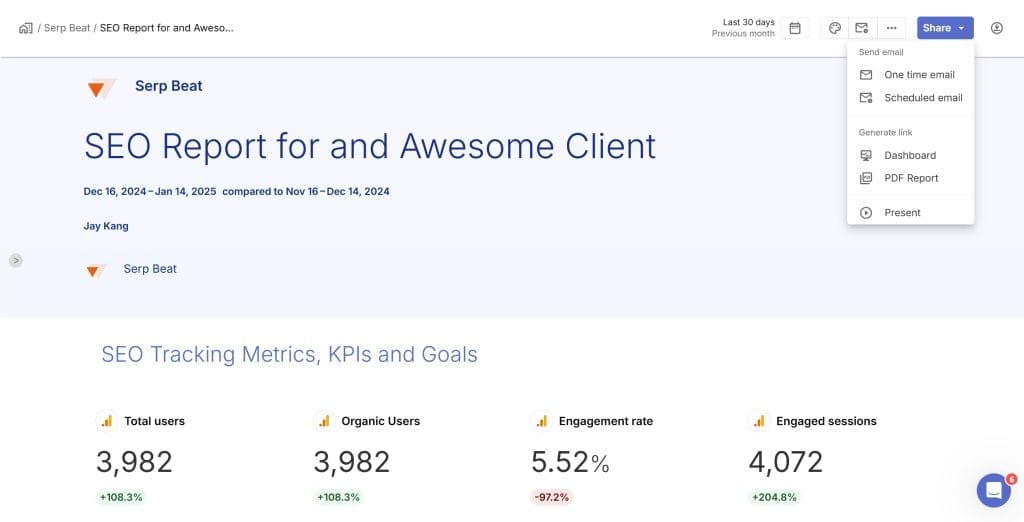
Price: $49/month (includes 10 data sources)
Swydos’ SEO reporting tool transforms how agencies handle multi-channel reporting. One agency owner reported slashing reporting time from hours to 15 minutes per client—a game-changer for busy teams.
Unlike per-client pricing, Swydo charges per data connection, offering better value for agencies managing SEO, PPC, and social for multiple clients. White-labeling is robust and free, with your logo, colors, and support for 14 languages. Automate reports as PDFs, emails, or shareable links for seamless delivery.
The catch? Swydo’s 34+ integrations are reliable but fewer than some competitors. Still, quality trumps quantity here.
Swydo’s Monitoring and Goal Tracking Tool
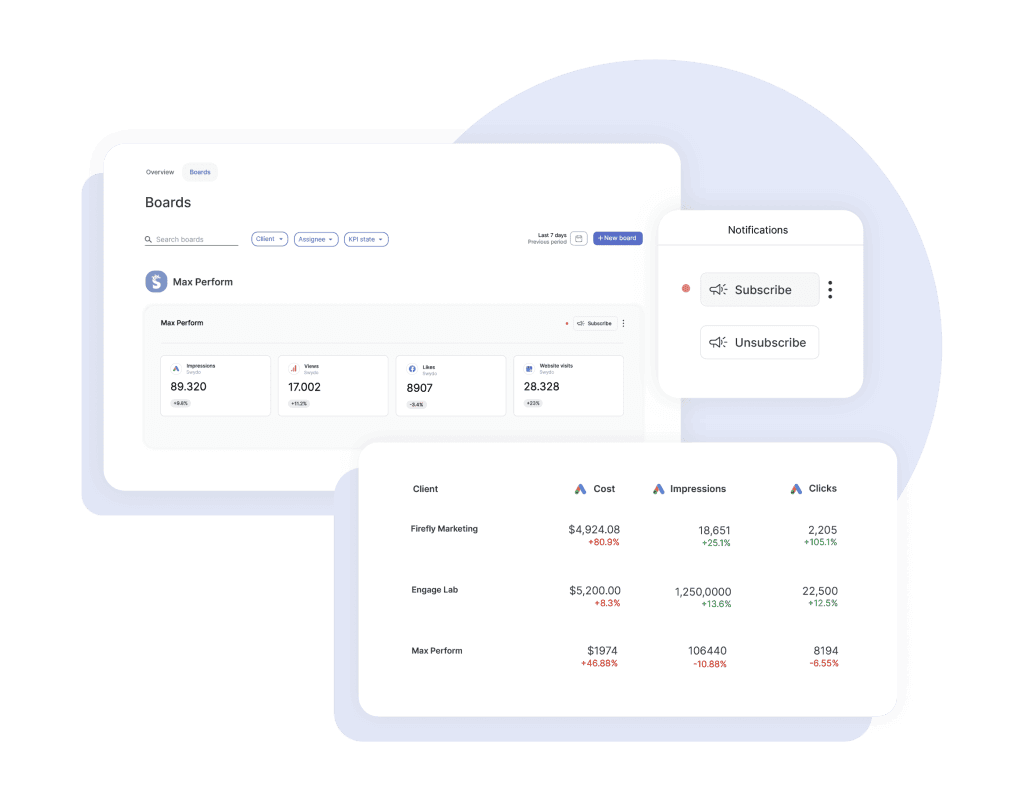
Swydo’s automated reporting tool empowers agencies to manage campaigns proactively, save time, and impress clients with clear insights. It streamlines workflows and drives results without the manual grind.
- Proactive Management: Real-time dashboards track KPIs like organic traffic or ad conversions, with green/red indicators highlighting trends instantly. Automated email alerts flag issues, like a dip in clicks, letting you act fast. This cuts manual checks, freeing your team for strategic work.
- Clear Client Communication: Visual dashboards turn complex data into client-friendly charts or tables. Blend metrics from Google Ads, Instagram Ads, or Google Analytics 4 to show campaign impact clearly, building trust and reducing client queries.
- Unified Multi-Channel Insights: The Combined Data Sources feature (in beta) merges data from up to five ad platforms (e.g., Google Ads, TikTok Ads) into one KPI, table, or chart. Display total ad spend or conversions in a single view to evaluate budget pacing or performance, saving hours on manual data merging and creating polished, high-level reports.
- Time-Saving Automation: Build dashboards quickly with pre-built templates or customize in minutes. Swydo auto-updates metrics and triggers alerts, slashing reporting time by up to 80% so your team can focus on growth.
- Actionable Decisions: Track KPIs against targets to spot high-performing pages or underperforming keywords. Filter clients by KPI state (good/bad) for quick prioritization, enabling data-driven strategies that boost client outcomes.
Is Swydo right for you? If you manage multiple channels and need efficient, client-friendly reporting, Swydo delivers. Its Monitoring and Goal Tracking, paired with Combined Data Sources, saves time, enhances communication, and supports scaling—all for $49/month. Ideal for agencies prioritizing value and impact.
2. Moz Pro Balances SEO and Reporting
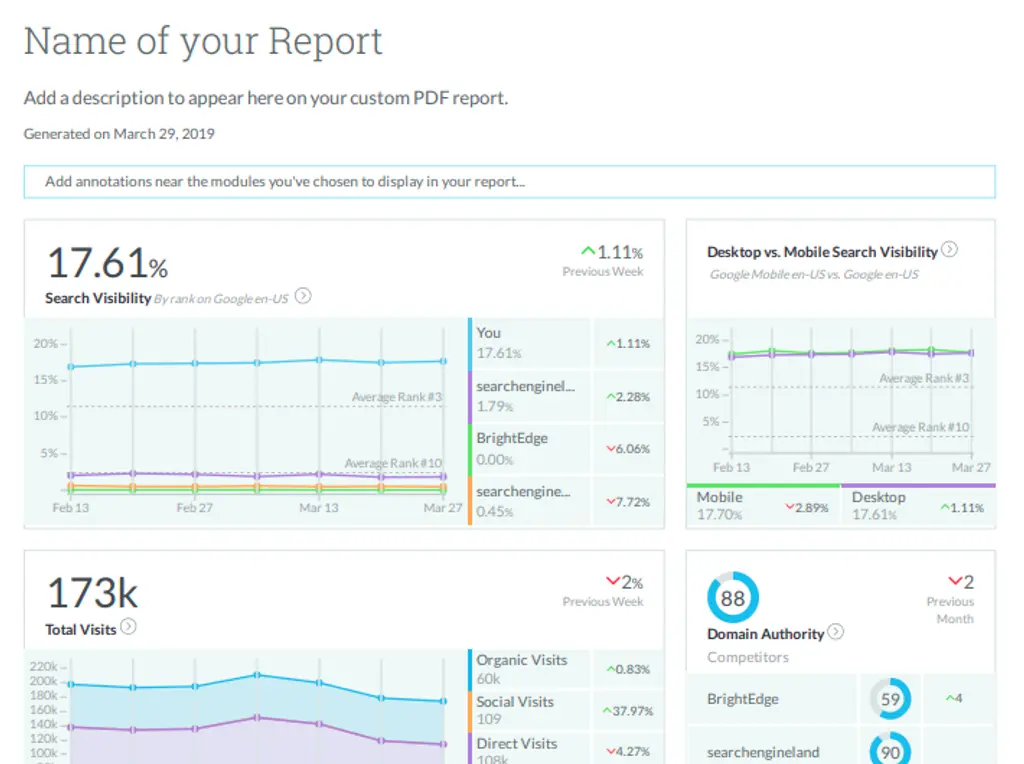
Price:
- Starter: $49/mo ($39/mo annually) – 1 user, 1 site, 50 keywords
- Standard: $99/mo ($79/mo annually) – 1 user, 3 sites, 300 keywords
- Medium: $179/mo ($143/mo annually) – 2 users, 10 sites, 1,500 keywords
- Large: $299/mo ($239/mo annually) – 3 users, 25 sites, 3,000 keywords
Moz has been around since the early days of SEO, and their platform balances execution tools with solid reporting capabilities. They’ve built their reputation on metrics like Domain Authority that clients actually understand, which makes your job explaining SEO progress much easier.
What I like about Moz is how approachable it is. New team members can get up to speed quickly, and the interface doesn’t overwhelm non-technical users. Custom PDF reports can be scheduled and branded (from the Medium plan up), though the customization isn’t as extensive as dedicated reporting platforms.
Where Moz really shines is with local businesses. Their separate Moz Local product offers specialized tools for listing management, review monitoring, and local rank tracking. If your client base consists mainly of local businesses like restaurants, law firms, or medical practices, the combination of Moz Pro and Moz Local gives you powerful coverage.
The downside? The tiered structure means you need to carefully plan around limits as you grow. Adding clients might push you into a higher tier, causing significant price jumps. Also, while reporting is solid, it’s not as automated or customizable as dedicated reporting tools.
Is Moz right for you? If you want a balanced platform that handles both SEO execution and reporting from a trusted name, especially for local businesses, Moz makes a lot of sense.
3. SEO PowerSuite Enables Unlimited Keyword Tracking
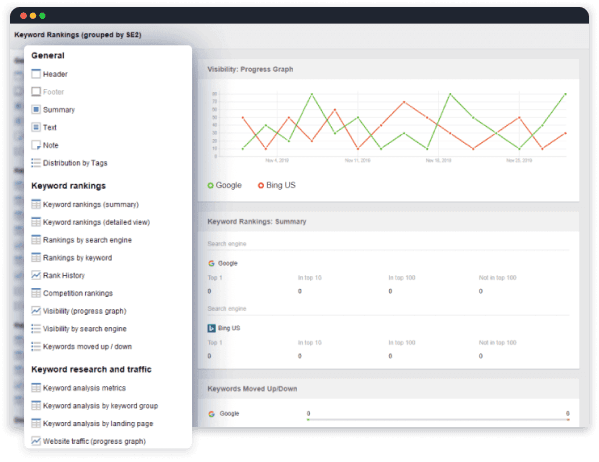
Price:
- Free version (€0): Basic features with limited functionality and 1 competitor per project
- Professional version (€179/year, approx $202 USD More features including 5 competitors per project, unlimited project saving, scheduled tasks, etc.
- Enterprise version (€419/year approx $474 USD): Full features with 40 competitors per project, watermark-free reports, advanced data exports, etc.
SEO PowerSuite takes a completely different approach as a desktop-based solution. And while that might sound old-school, it creates some unique advantages — especially for agencies tracking tons of keywords.
The biggest selling point? Unlimited keyword tracking for a flat annual fee. Most cloud tools charge you more as you add keywords, which can get expensive fast. If you’re monitoring thousands of keywords across multiple clients, the savings can be enormous.
The software is blazing fast too. Users report checking hundreds of keywords across multiple search engines in under a minute. Reports can be white-labeled and customized, though distribution is more manual than cloud platforms.
The desktop approach does have drawbacks. Collaboration is more challenging, and you don’t get the seamless API connections of cloud tools. It’s also more suited to technical users who don’t mind a slightly steeper learning curve.
Is SEO PowerSuite right for you? If you’re monitoring massive keyword sets and prefer to own your software rather than rent it, the value proposition is compelling. You’ll trade some automation for substantial cost savings at scale.
4. Screaming Frog Excels in Technical Audits
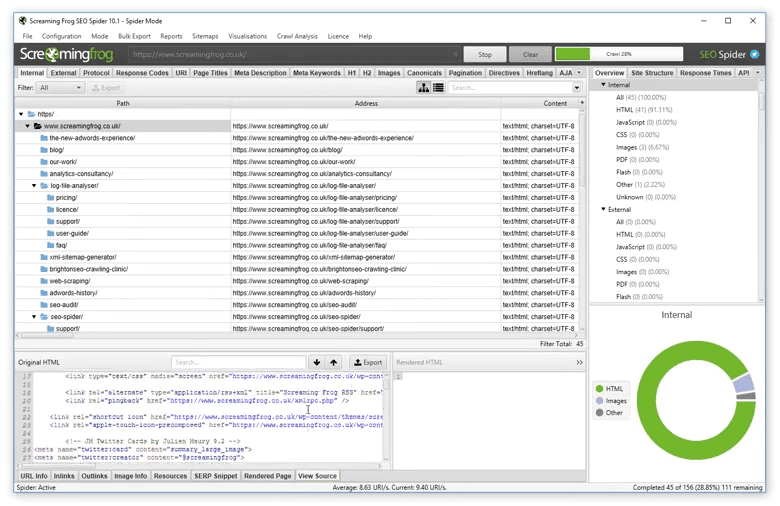
Price:
- Free version: Limited to 500 URLs per crawl
- Paid license: £199 ($259) per year per user
Screaming Frog isn’t trying to be a comprehensive reporting platform — and that’s its strength. It’s laser-focused on being the best technical SEO crawler in the business. Every serious agency I know has at least one license.
The tool excels at rapidly crawling websites to identify technical issues, from broken links and redirect chains to duplicate content and structured data problems. It’s fast, thorough, and unmatched for technical diagnostics.
The reporting is where things get interesting. Screaming Frog is built for SEO practitioners, not for client presentations. While it can export comprehensive data, you’ll typically need to process that information into more client-friendly formats.
Is Screaming Frog right for you? It’s not a question of “if” but “how” you use it. Most agencies pair it with other reporting tools, using Screaming Frog for the technical heavy lifting and then translating those findings into client-friendly reports through platforms like Swydo or even custom presentations.
5. Google Free Tools Provide Essential Data
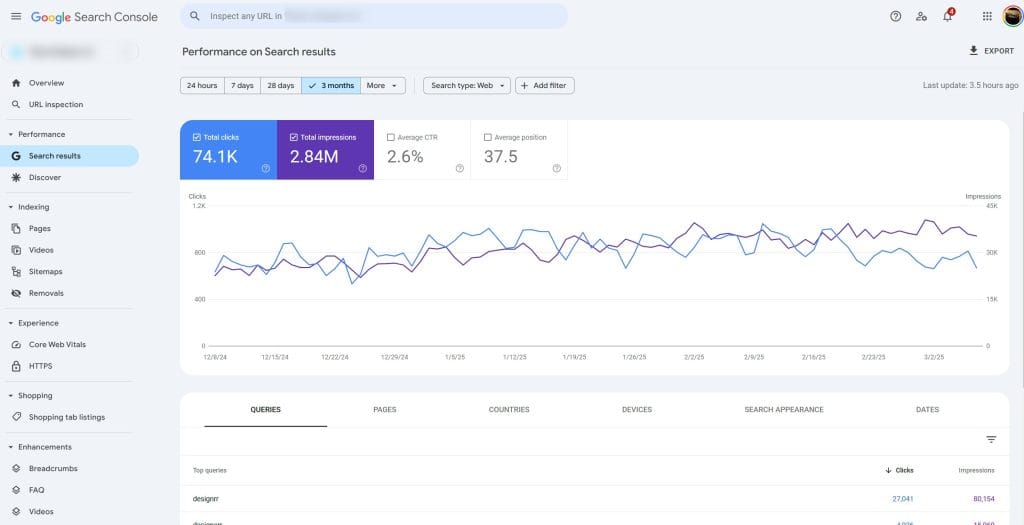
Price: Free
Let’s not overlook what’s right under our noses. Google provides powerful tools that cost absolutely nothing:
- Google Analytics 4 gives you comprehensive traffic and user behavior data
- Google Search Console provides direct keyword and indexing insights
- Google Looker Studio creates customizable dashboards and reports
These tools require more manual setup than paid alternatives, but they provide direct access to Google’s data — eliminating questions about accuracy that can plague third-party tools.
The primary limitation is time investment. Building and maintaining custom reports takes significant effort, especially when handling multiple clients. There’s also limited white-labeling, though you can add your logo and some brand colors.
Are Google’s tools right for you? They form the foundation of virtually every agency’s reporting stack. For startups or agencies with technical team members, they might be sufficient alone. Most established agencies use them as data sources for more automated platforms that reduce manual reporting time.
| Tool | Key Features | Limitations |
|---|---|---|
| Google Analytics 4 | Traffic, user behavior data | Manual setup, limited branding |
| Google Search Console | Keyword, indexing insights | Time-intensive for multiple clients |
| Google Looker Studio | Customizable dashboards, reports | Requires technical effort |
Major SEO Platforms with Robust Reporting Tools
Let’s talk about some of the heavy hitters in the SEO world. These are the tools most SEO professionals know by name – the ones that offer comprehensive functionality beyond just reporting. But how good are they when it comes specifically to showing your clients results?
6. Semrush Offers Comprehensive SEO Solutions
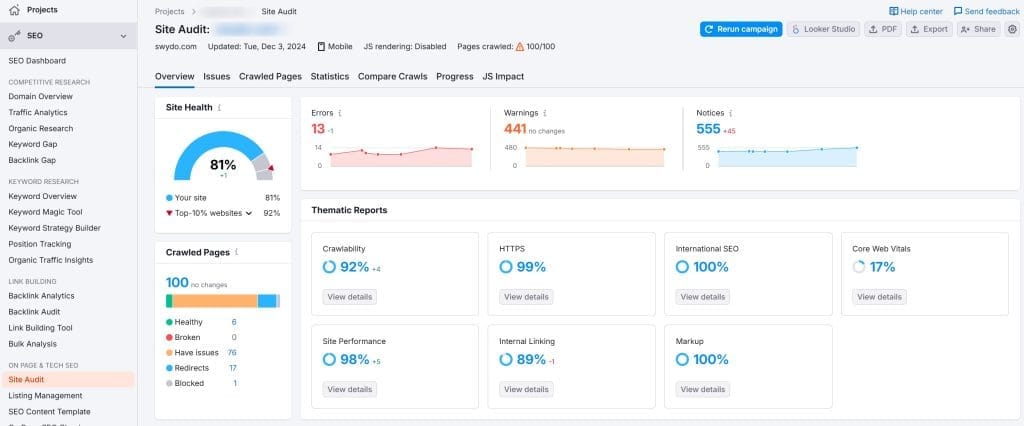
Current Pricing (2025):
- Pro: $139.95/month
- Guru: $249.95/month
- Business: $499.95/month
- Enterprise: Custom pricing
Ever feel like you’re juggling too many tools? Semrush tries to solve that problem by offering everything from keyword research to competitive analysis to content tools under one roof.
What I love about Semrush’s reporting capabilities is their “My Reports” tool. It lets you pull data from across their entire platform and present it in a single, cohesive report. No more bouncing between dashboards or manually merging data from different sources. You can even add an AI Summary that automatically explains what the data means in plain English.
Their white-labeling options (available through their Agency Growth Kit add-on) are solid, though not as flexible as dedicated reporting platforms. Reports can be scheduled for automated delivery, which saves you from the monthly reporting scramble.
The downside? All that power comes with complexity. Their interface can feel overwhelming, especially to newcomers. And the pricing model gets expensive fast – the base prices only include one user seat, with additional users costing $45-100 each per month. Add the Agency Growth Kit ($69+/month) for white-labeling, and you’re looking at a significant investment.
Best for: Agencies that want a single platform to handle both SEO execution and reporting, especially those who value depth of data over reporting simplicity.
7. Ahrefs Dominates Backlink Analysis
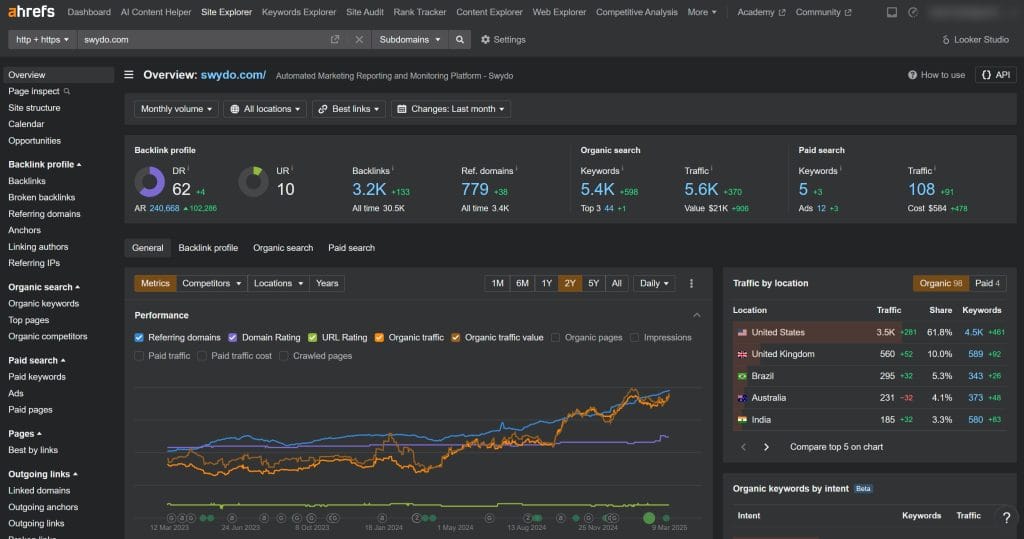
Current Pricing (2025):
- Lite: $129/month ($108/month annually)
- Standard: $249/month ($208/month annually)
- Advanced: $449/month ($374/month annually)
- Enterprise: $1,499/month ($1,249/month annually)
- Additional users: $40-100/month
- Report Builder (Add-on): $99/month
You know that feeling when you find a restaurant that does one dish absolutely perfectly? That’s Ahrefs with backlink analysis. While they’ve expanded their feature set dramatically over the years, their backlink data remains the gold standard.
Ahrefs’ reporting capabilities have improved with their Report Builder add-on, but reporting isn’t their primary focus. The reports are professional and can be white-labeled, but the customization options and automation features lag behind dedicated reporting platforms.
Where Ahrefs really shines is data quality. If you’re showing clients backlink growth or competitive link gap analysis, the depth and accuracy of their data makes your reports more credible. Their interface is generally cleaner and more intuitive than Semrush, with a focus on making complex data accessible.
Like Semrush, their pricing structure gets expensive quickly. The base prices include just one user, with additional users costing $40-100/month. The Report Builder add-on runs another $99/month, and some agencies find their newer credit-based limits frustrating.
Best for: Agencies focused on link building and technical SEO who prioritize data quality over reporting automation.
8. SE Ranking Delivers Affordable SEO Features
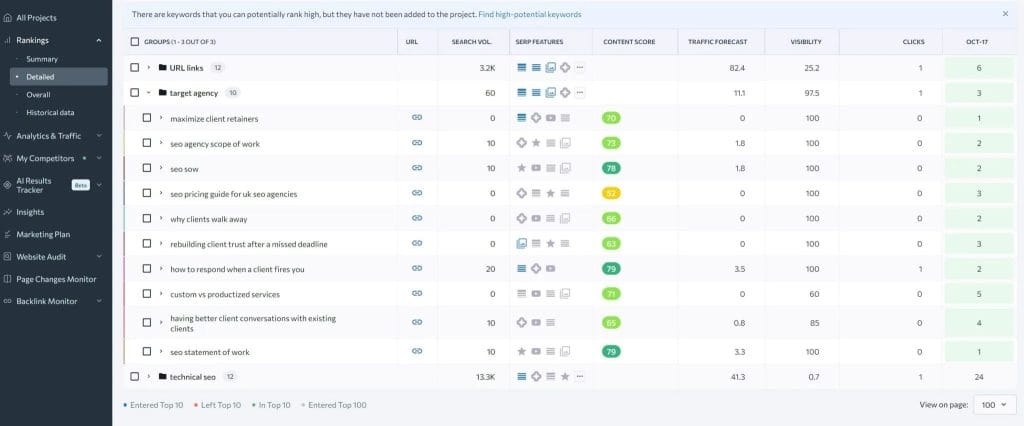
Current Pricing (2025):
- Essential: $65/month (varies based on keywords and update frequency)
- Pro: $95-119/month
- Business: $207-259/month
- Enterprise: Custom pricing
- Agency Pack (Add-on): +$50/month
Ever feel like the big SEO tools are pricing themselves out of reach for smaller agencies? SE Ranking positions itself as the affordable alternative that doesn’t sacrifice too much functionality.
SE Ranking offers comprehensive SEO tools including rank tracking, site audits, backlink analysis, and competitor research. Their reporting features include customizable white-label reports that can be scheduled and automated. Reports are clean and professional, though not as deeply customizable as dedicated reporting platforms.
What sets SE Ranking apart is their focus on user-friendliness and affordability. The interface is more approachable than Semrush or Ahrefs, making it easier for team members to get up to speed. Their Agency Pack add-on ($50/month) adds lead generation tools and client management features specifically designed for agencies.
The main limitation is data depth – while they cover all the essential SEO areas, their databases aren’t as vast as the premium tools. For agencies focused primarily on rank tracking, this may not be an issue, but for deep backlink analysis or comprehensive keyword research, you might feel the limitations.
Best for: Growing agencies looking for a balance of features, usability, and affordability without the premium price tags of market leaders.
9. AccuRanker Specializes in Precise Rank Tracking
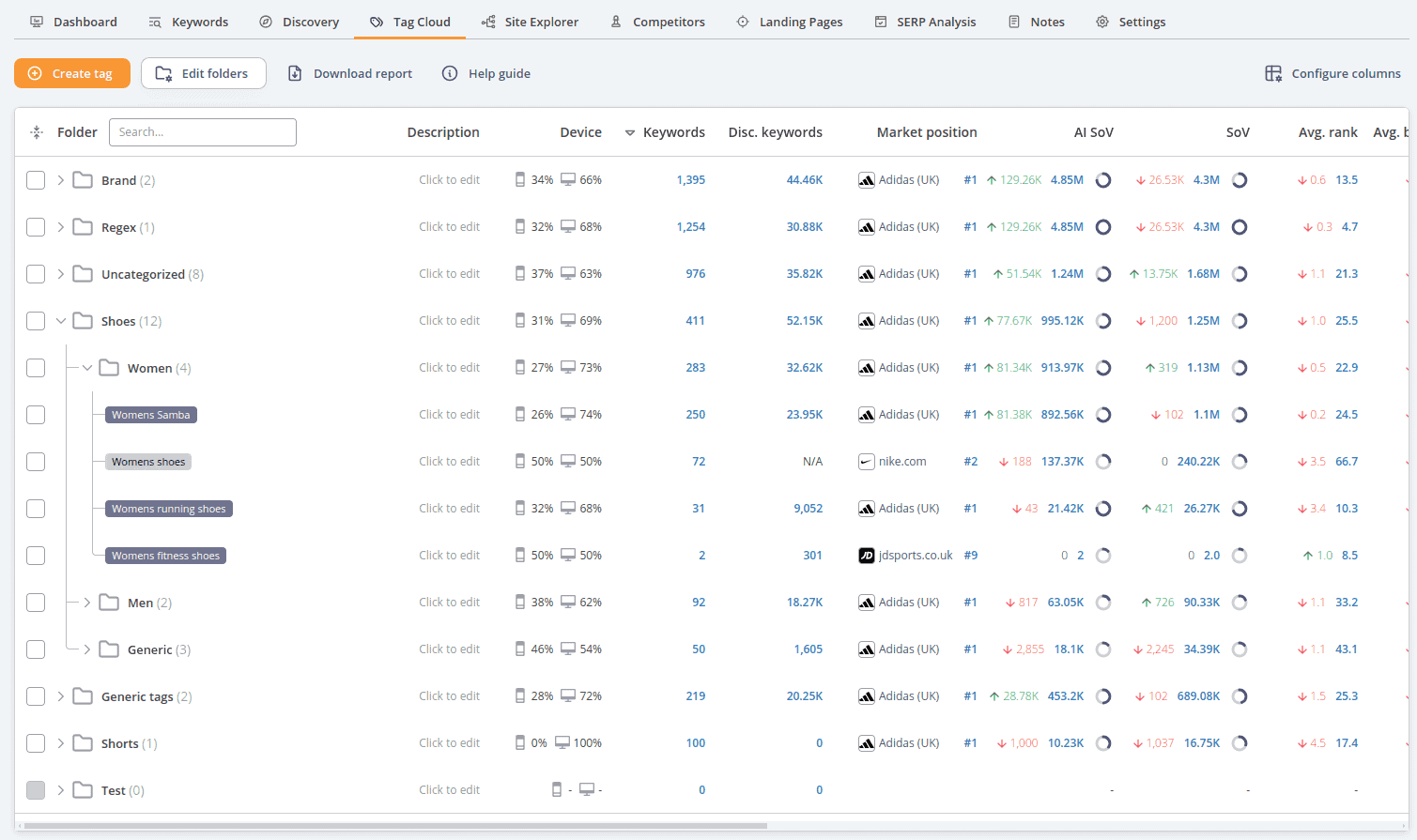
Current Pricing (2025):
- Based on keyword volume, starting around $129/month
- 10% discount for annual billing
How many of your clients are absolutely obsessed with rankings? If you’re nodding emphatically, AccuRanker might deserve your attention. It does one thing – rank tracking – with exceptional precision and speed.
AccuRanker isn’t trying to be an all-in-one SEO suite. Instead, it’s laser-focused on being the best rank tracker in the business. What makes it special? It updates rankings instantly on demand (most tools take hours or have daily limits), tracks both desktop and mobile rankings, and offers unparalleled location specificity – you can track rankings down to a specific street or zip code.
The reporting is clean and straightforward, focusing on ranking data visualization and competitor comparisons. You can create custom reports, export to PDF, and schedule automated delivery. What you won’t get is the breadth of data from all-in-one platforms – there’s no backlink data, content analysis, or technical SEO auditing.
The pricing is based purely on keyword volume, which makes it transparent but potentially expensive for agencies tracking thousands of keywords across multiple clients. Unlike tiered platforms where you might get bundled features, with AccuRanker you’re paying specifically for rank tracking capabilities.
Best for: Agencies with clients who prioritize ranking improvements above all other SEO metrics, especially those needing highly localized or on-demand ranking data.
| Tool | Pricing | Best For |
|---|---|---|
| Swydo | $49/month (10 data sources) | Multi-channel reporting efficiency |
| Moz Pro | $49-$299/month, Moz Local $20-40/month | All-in-one for local businesses |
| SEO PowerSuite | $200-$474/year | Unlimited keyword tracking |
| Screaming Frog | £199 ($259)/year | Technical SEO audits |
| Google Tools | Free | Foundational data for all agencies |
| Semrush | $139.95-$499.95/month | Comprehensive SEO and reporting |
| Ahrefs | $129-$1,499/month | Backlink analysis focus |
| SE Ranking | $65-$259/month | Budget-friendly alternative |
| AccuRanker | $129/month | Precise rank tracking |
How to Choose the Most Cost-Effective Tool
Let’s be practical. Budget matters. But the “cheapest” tool isn’t always the most cost-effective when you factor in time savings and value delivered. Here’s how I break it down for different agency situations:
- Just Starting Out (1-3 Clients): When you’re new, cash flow is king. Leverage Google’s free tools while you build your client base. Invest the time in creating custom Looker Studio dashboards — it’s manageable with just a few clients, and the skills will serve you well regardless of what tools you add later.
- Growing Fast (5-15 Clients+): This is where dedicated reporting tools start to pay for themselves. Swydo’s $49/month baseline with added sources as needed provides exceptional value as you scale. The time savings will quickly outweigh the investment, freeing your team to focus on revenue-generating activities.
- Keyword-Intensive Campaigns: If your clients need tracking for thousands of keywords, especially across multiple locations, SEO PowerSuite’s flat annual fee ($299) with unlimited tracking is unbeatable. Cloud tools with per-keyword pricing would cost exponentially more for the same capability.
- Local Business Specialists: Agencies serving local businesses have unique needs. Moz Local ($129-$299/year per location) provides specialized local SEO features that generic platforms can’t match. For multi-location clients, build the subscription cost into your service packages.
Remember, the real cost equation isn’t just the software price — it’s that plus the time your team spends using it. A seemingly “expensive” tool that saves 10 hours per month might actually be cheaper than a “budget” option that requires extensive manual work.
| Agency Scenario | Recommended Tool | Why It Fits |
|---|---|---|
| 1-3 Clients | Google’s Free Tools | Low cost, builds skills |
| 5-15+ Clients | Swydo ($49/month) | Time savings for scaling |
| Keyword-Intensive | SEO PowerSuite ($200/year) | Unlimited tracking, cost-effective |
| Local Businesses | Moz Local ($20-40/year) | Specialized local SEO features |
Three Models to Optimize Your Reporting Stack
After evaluating hundreds of agency reporting setups, I’ve identified three dominant models that balance effectiveness with resource constraints:
All-in-One Platform for Streamlined SEO
Implementation Strategy: Select a comprehensive SEO platform like Semrush, Ahrefs, Moz Pro, or SE Ranking as your primary tool for both execution and reporting.
- Advantages:
- Unified workflow between SEO activities and reporting
- Consistent methodology and metrics
- Simplified tool management and training
- Potential cost savings versus multiple specialized tools
- Disadvantages:
- Less sophisticated multi-channel reporting
- Typically weaker customization and white-labeling
- Often more expensive to add team members
- Feature compromises compared to specialized tools
Best For: SEO-focused agencies with streamlined service offerings and teams under 10 members.
Specialized Tools for Precision Reporting
Implementation Strategy: Combine specialized tools for different functions:
- Technical auditing: Screaming Frog SEO Spider
- Rank tracking: AccuRanker, SE Ranking or SEO PowerSuite Rank Tracker
- Local SEO: Moz Local
- Reporting visualization: Google Looker Studio or Swydo
- Advantages:
- Best-in-class capabilities for each function
- Superior data depth and precision
- More economical team scaling (add users only to needed tools)
- Maximum flexibility to adapt to client needs
- Disadvantages:
- Higher manual integration requirements
- More complex training and workflow management
- Potential methodology inconsistencies between tools
- More time-intensive reporting process
Best For: Technical SEO agencies with dedicated specialists and custom reporting needs.
Hybrid Approach for Balanced Efficiency
Implementation Strategy: Use a core all-in-one platform for primary SEO work, supplemented by a cross-channel reporting tool and specialized audit software.
Example: Semrush or Ahrefs (core SEO) + Swydo (reporting) + Screaming Frog (technical audits)
- Advantages:
- Balances workflow efficiency with reporting sophistication
- Leverages strengths of both approach types
- Adaptable to different client reporting needs
- Streamlines multi-channel reporting
- Disadvantages:
- Requires careful integration planning
- Some functional redundancy across tools
- More complex than all-in-one but less flexible than specialized approach
- Higher total cost than all-in-one alone
Best For: Full-service agencies managing multiple marketing channels alongside SEO.
How to Create an Effective Reporting System
Getting the right tools is just the first step. The real magic happens in how you implement them. Let me share what I’ve seen work best after helping dozens of agencies overhaul their reporting systems.
Templates Tailored to Client Needs
You know what’s almost as bad as no reports? Reports that nobody understands. Your clients come from different industries and have different goals. Why would you give them all identical reports?
Think about it like this: A local restaurant wants to know about their Google Business Profile performance and local rankings. An e-commerce store cares about product page visibility and conversion paths. Your reporting needs to reflect these differences.
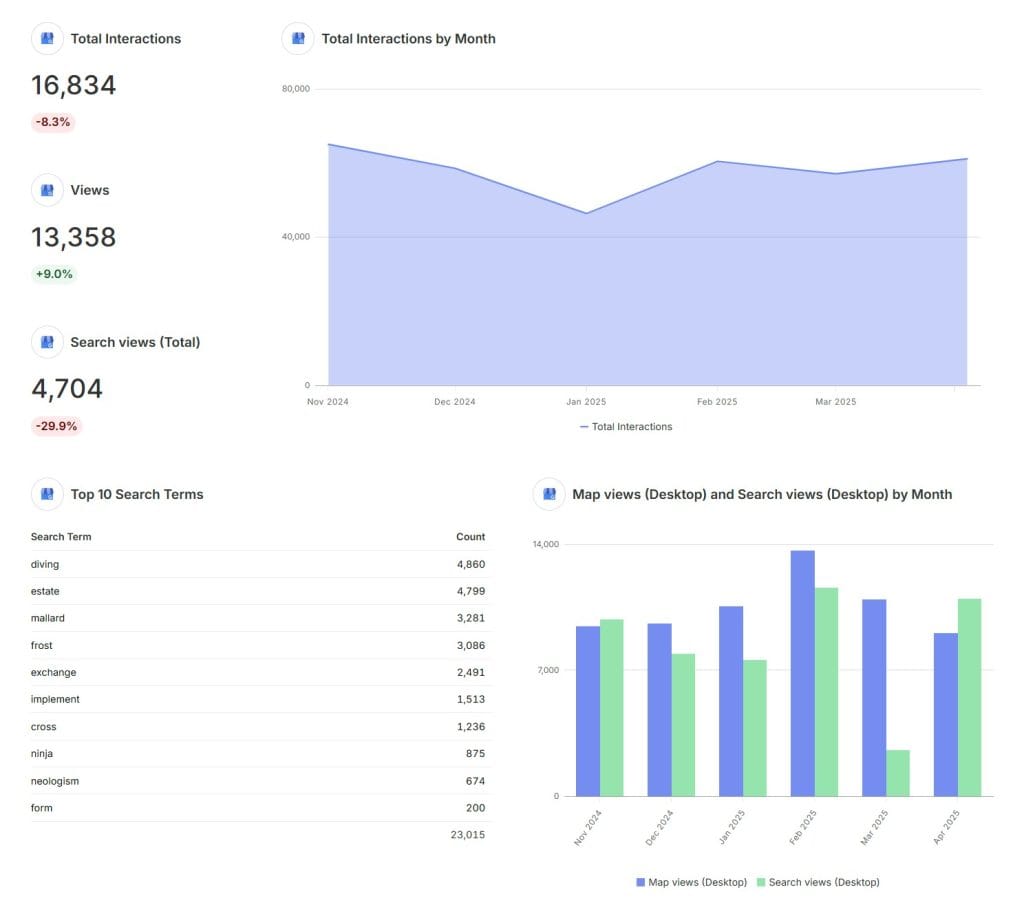
Start by developing a few core templates:
- Local business focus
- E-commerce focus
- B2B service focus
For each template, include an executive summary first. Not everyone wants to dig into the data depths. Give busy executives what they need in the first 30 seconds, then provide the detailed stuff for those who want it.
And please, be consistent with your visuals! Use the same colors for the same metrics across all reports. If green means “good” in one chart, don’t use it for “bad” in another. These small details make a huge difference in how quickly clients can absorb information.
Workflow That Enhances Efficiency
Have you ever had a report delayed because the one person who knows how to run it was out sick? Or sent a report with errors because three different people worked on it without clear coordination? Workflow matters.
Here’s a simple but effective approach I’ve seen work well:
- Junior staff pulls the initial data and builds the report framework
- SEO specialists add analysis and recommendations
- Account managers add client-specific context and final review
Define who does what, when they do it, and how handoffs happen. Create checklists for each role so nothing gets missed. And automate whatever you can — most tools let you schedule data refreshes and even delivery.
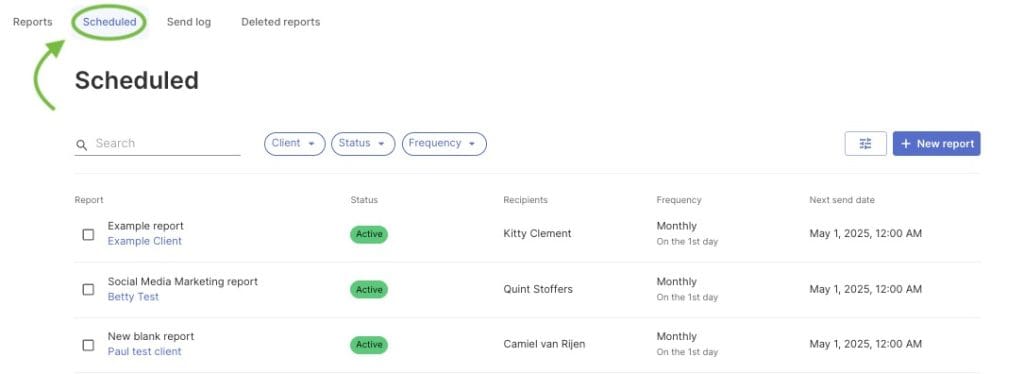
Metrics to Measure Reporting ROI
How do you know if your new reporting system is actually worth what you’re paying for it? You track the impact.
For immediate ROI, track time savings:
- Hours spent on reporting before vs. after
- Cost of those hours based on staff rates
- Value of freed-up time redirected to billable work
For longer-term ROI, watch these metrics:
- Client retention rates
- Feedback scores on reporting quality
- Team satisfaction and reduced stress
- Ability to take on new clients without adding staff
One agency I worked with saved over 40 hours monthly after implementing a proper reporting system. That’s a full work week they could redirect to growth activities instead of spreadsheet wrangling.
Why Audit Tools Fall Short for Client Reporting
I get this question a lot. “Can’t I just use the reports that come with my SEO audit tool?”
Well, you can. But there’s a big difference between what these tools provide and what makes for effective client reporting.
Audit tools like Screaming Frog give you fantastic data exports. They’ll tell you about every broken link, missing meta description, and crawl issue. That’s incredibly valuable for your team’s work. But it’s not what clients need to see.
Most audit tool reports are designed for SEO practitioners, not business owners. They focus on technical details rather than business outcomes. They’re heavy on data but light on context and recommendations.
Think about it from your client’s perspective. Do they really care about a list of 302 redirects? Or do they want to know how your work is improving their business? Technical reports have their place, but they should feed into your client-facing reporting, not replace it.
The agencies that get the best results typically use specialized tools for different purposes:
- Technical audit tools to identify issues
- Rank tracking tools to monitor visibility
- Analytics platforms to track user behavior
- Reporting platforms to bring it all together in a client-friendly format
This division of labor lets each tool do what it does best, creating a more effective overall system.
Action Plan to Upgrade Your Reporting
If you’re still using manual reporting processes or cobbling together data from multiple sources, you’re leaving money on the table. Not just in wasted time, but in missed opportunities to showcase your value to clients.
Here’s a simple action plan to move forward:
- Audit your current process. How much time is your team really spending on reporting? What’s the quality of the insights you’re delivering? Be honest about the gaps.
- Define your priorities. Is time savings your biggest concern? White-labeling? Data integration? Different tools excel in different areas.
- Start small but start now. You don’t need to overhaul everything overnight. Begin with one or two clients, perfect your approach, then expand.
The “best” reporting tool isn’t necessarily the one with the most features. It’s the one that actually fits your agency’s workflow and client needs. Sometimes a simpler but consistent system delivers better results than a complex one that nobody fully utilizes.
So which approach makes the most sense for your agency? That’s ultimately a question only you can answer based on your specific needs, client base, and team structure. But I hope this guide has given you a clear roadmap for making that decision.
- Why SEO Reports Strengthen Client Relationships
- Why Excel Fails for Scaling Agencies
- What Are Essential Features of an SEO Reporting Tool
- Six Critical SEO Report Types for Clients
- Local SEO Report for Geographic Performance
- Top SEO Reporting Tools for Agency Needs
- Major SEO Platforms with Robust Reporting Tools
- How to Choose the Most Cost-Effective Tool
- Three Models to Optimize Your Reporting Stack
- How to Create an Effective Reporting System
- Why Audit Tools Fall Short for Client Reporting
- Action Plan to Upgrade Your Reporting
